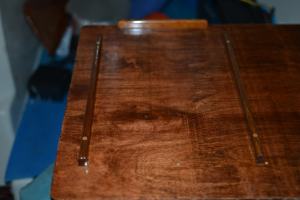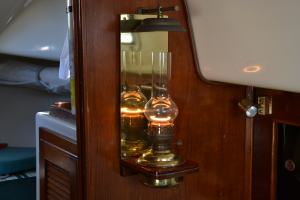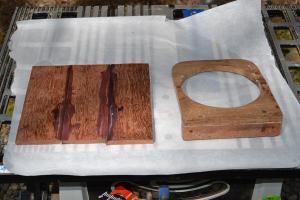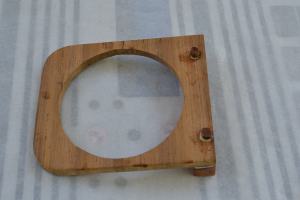Sounds a lot like watching paint dry or grass grow. Yeah. You need something else to do in the mean time. I had ground out and refilled “one more time” (actually, once more than my impatient nature wanted to) those areas that really needed one more application. I was waiting for them to cure so I could grind them smooth before I put the tools away for the day.
So while I was waiting, I decided to begin the small mods needed in my galley to accommodate my new Origo stove. I posted about this here, a few weeks back.
I needed to fabricate more fiddles to hold the stove in place: several for the “storage position,” behind the chart table, and several for the “in-use” position, with chart table open. There were already two in place, so I dismounted them and brought them home for copying in the shop.
First I selected the materials. I have some left-over teak decking (.5″ x 2″) from another project, and that halved seemed just about right. So, here is a photo of the teak lumber, and the existing fiddles from my chart table.

Teak: finished and raw
Next step was to cut to length, then rip in half. That left me 4 rectangular pieces.
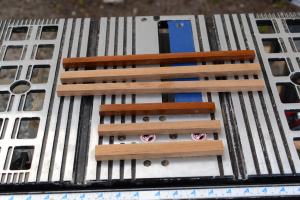
Next step was to round off one side of each piece so that the fiddles have a squared off base and rounded top profile. I thought for a while how to achieve this. In the past I have clamped my belt sander into a jig – which converts it to a stationary sander – and shaped the piece at hand that way. But sometimes a hand tool is faster and flexible. I chose to attempt the shaping with my block plane. The results weren’t perfect, but when I’m through sanding them, I doubt you will be able to notice the difference from shaped on a power sander or planed by hand.
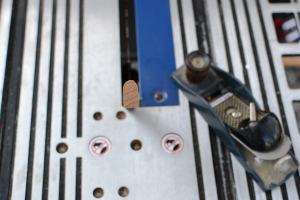
You are looking at the end of a new fiddle, shaped by the plane on right
Finally, you might have noticed that the short fiddle in the bottom of the photograph above looks to be cut larger than the others. That’s because I didn’t get it centered perfectly on the saw. I rarely do anything “just right,” but happily, it serves my purpose this time, I will use the taller of the pieces in the storage position, aft-most in the space. This will make me feel a bit more secure when the boat is pitching in a seaway if that fiddle is a bit taller.
Cabin Heat
I’ve been casting about for years on this subject, and think I’ve lighted upon a workable solution. A few years ago, I happened upon ownership of a large trawler lamp that was being discarded. I have admired these things for years, but having no real space or use for one, I never bought one. Never even thought about it, realistically. However, this was a windfall, and I availed myself of the opportunity to own one. That was five or six years ago, and it has been used in a purely decorative fashion since then. In my house. The boat is too small to accommodate it.

Trawler Lamp in my living room
I have always noted that the lamp put out an incredible amount of heat. This winter, as I used the lamp in our home, the light went on for me, so to speak. The circular wick in this large-format oil lamp is a veritable furnace. Even on a low setting it really puts out heat. I could use this to heat the boat. I just have to figure out how to mount it.
My plan is to fabricate from hardwood a circular bracket (in other words, I cut a hole into a piece of wood). The hole will accommodate the narrow dimension of the oil tank, but will not allow the flange at the top of the tank to pass through. This is how it is mounted in its own frame. Mount the bracket on the bulkhead, and mount the smoke bell that I found at Bacon’s over it.

Smoke Bell from Bacon's. I've been looking for this model that has the adjustable bell position

Profile view
As it rained today, I could neither work on the boat nor work on my shop projects, because my “shop” is outside in my driveway, and my tools are stored in a shed. So in lieu of a rain-safe location to work, I blogged instead.
